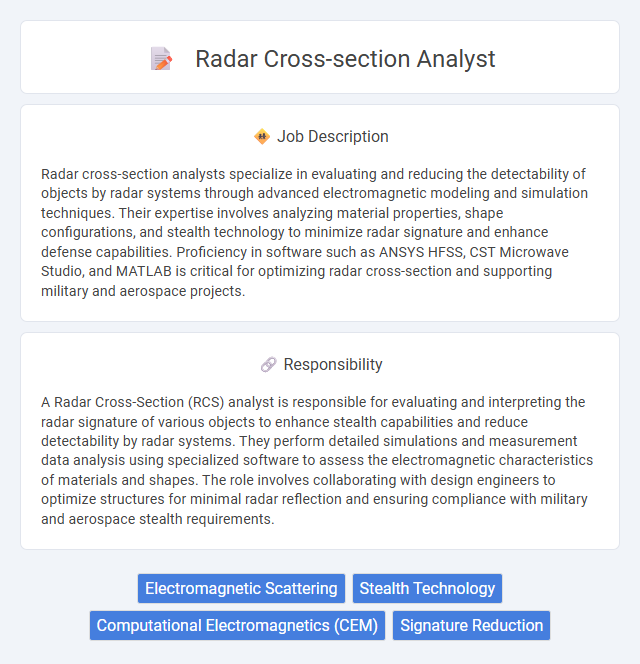
Radar cross-section analysts specialize in evaluating and reducing the detectability of objects by radar systems through advanced electromagnetic modeling and simulation techniques. Their expertise involves analyzing material properties, shape configurations, and stealth technology to minimize radar signature and enhance defense capabilities. Proficiency in software such as ANSYS HFSS, CST Microwave Studio, and MATLAB is critical for optimizing radar cross-section and supporting military and aerospace projects.
Individuals with strong analytical skills and an aptitude for physics and mathematics are likely suitable for a Radar Cross-Section (RCS) analyst role, as the job requires interpreting complex radar data and simulating electromagnetic wave interactions. People who prefer detailed, research-driven tasks and can work independently under pressure may find this position fitting, given its focus on precision and problem-solving. Those who struggle with intricate technical concepts or prefer highly social work environments might face challenges in adapting to the demands of RCS analysis.
Qualification
Radar cross-section analysts require strong expertise in electromagnetic theory, signal processing, and radar system design. Proficiency in simulation software such as CST Microwave Studio, ANSYS HFSS, or MATLAB is essential for accurate RCS prediction and analysis. A background in aerospace engineering, physics, or electrical engineering, often supported by an advanced degree, enhances the ability to evaluate stealth technology and optimize radar signature reduction techniques.
Responsibility
A Radar Cross-Section (RCS) analyst is responsible for evaluating and interpreting the radar signature of various objects to enhance stealth capabilities and reduce detectability by radar systems. They perform detailed simulations and measurement data analysis using specialized software to assess the electromagnetic characteristics of materials and shapes. The role involves collaborating with design engineers to optimize structures for minimal radar reflection and ensuring compliance with military and aerospace stealth requirements.
Benefit
Radar cross-section analysts likely experience benefits such as enhancing stealth technology efficiency, contributing to national security improvements, and gaining expertise in advanced electromagnetic theory applications. This role may also provide opportunities for career growth in defense and aerospace industries due to the specialized skill set required. Professionals in this field are probably rewarded with competitive salaries and the chance to work on cutting-edge projects.
Challenge
Radar cross-section analysts likely face the challenge of accurately predicting how objects scatter electromagnetic waves under varying conditions. The complexity of stealth technology and the need for precise modeling may require constant adaptation to evolving radar systems and materials. Handling large datasets and integrating multidisciplinary knowledge probably adds to the analytical demands of the role.
Career Advancement
Radar cross-section analysts specialize in evaluating and minimizing an object's detectability by radar, utilizing advanced simulation tools and electromagnetic theory. Career advancement opportunities include roles such as senior analyst, project manager, or technical lead in defense contractors, aerospace companies, and government agencies. Developing expertise in signal processing, stealth technology, and gaining certifications in radar systems enhances prospects for leadership and specialized consulting positions.
Key Terms
Electromagnetic Scattering
Radar cross-section (RCS) analysts specialize in evaluating how electromagnetic waves scatter when they encounter various objects, using advanced computational models to predict an object's detectability by radar systems. Proficiency in electromagnetic scattering theory, numerical methods like the method of moments or finite element analysis, and hands-on experience with simulation software such as CST Microwave Studio or ANSYS HFSS are essential for accurate RCS predictions. Their work supports the design of stealth technology, aerospace vehicles, and military defense systems by optimizing shapes and materials to minimize radar detectability.
Stealth Technology
Radar cross-section analysts specialize in evaluating and minimizing the detectability of objects, particularly in stealth technology applications. They use advanced simulation tools and electromagnetic theory to assess how radar waves interact with surfaces, ensuring aircraft and vessels maintain low observability. Expertise in materials science, radar signal processing, and geometric shaping directly enhances the effectiveness of stealth designs.
Computational Electromagnetics (CEM)
Radar cross-section analysts specializing in Computational Electromagnetics (CEM) employ advanced simulation tools such as the Method of Moments (MoM) and Finite Difference Time Domain (FDTD) to model and predict electromagnetic wave interactions with various materials and complex geometries. These experts analyze scattering characteristics to optimize stealth technology and improve radar detection accuracy, utilizing software like ANSYS HFSS, CST Microwave Studio, or FEKO for precise RCS calculations. Proficiency in Maxwell's equations and high-performance computing enables the evaluation of target signatures in diverse operational scenarios, supporting defense and aerospace applications.
Signature Reduction
A Radar Cross-Section (RCS) Analyst specializes in evaluating and minimizing the detectability of objects by radar systems through advanced signature reduction techniques. They use computational modeling, electromagnetic simulation tools, and material analysis to optimize stealth features in aircraft, naval vessels, and other defense assets. This role requires expertise in radar signal behavior, absorption materials, and shape design to achieve tactical advantages by lowering radar visibility.
 kuljobs.com
kuljobs.com